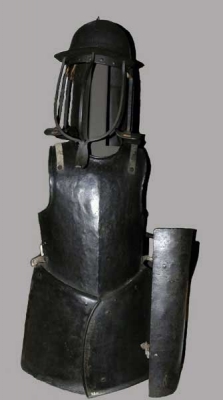Pikeman's Civil War Armour (1884.31.10)
 EnglandPikeman's Civil War Armour from England, Europe. Part of the Pitt Rivers Museum Founding Collection. Given to the Museum in 1884.
EnglandPikeman's Civil War Armour from England, Europe. Part of the Pitt Rivers Museum Founding Collection. Given to the Museum in 1884.
This is a pikeman's heavy iron siege armour form the period of the English Civil War (1642-1651).
Form and Function
During the Tudor period, the rising quality of plate armour and firearms meant that the longbow, which had dominated English warfare for centuries, became ineffective and was abandoned in favour of the pike, a massive spear up to six metres in length. The army of Queen Elizabeth I (reigned 1558-1603) largely comprised pikemen and arqebusiers. The arquebus was a very early type of gun that predated the musket. Good plate armour could repel its low-velocity balls at range and this, combined with its relative inaccuracy meant that, on the field, the pike remained the primary weapon of the two.
Pikemen moved on the battlefield in large numbers, organised into various formations, such as the phalanx, hedgehog and square. Provided the pikemen held their ground, these formations were impenetrable to the dreaded cavalry charge. The development of pike-based tactics heavily decreased the ability of cavalry to move quickly around the battlefield, which had always been their decisive strength. Under this 'New Discipline' of military tactics (as it was known), infantry began to appear on the battlefield in chequered formations of pikemen and musketeers (termed 'shot and pike'). The musketeers of each unit tried to shoot enough pikemen of the enemy to create a gap in the wall of pikes, which would then allow the waiting cavalry to charge in and cut the men down with swords. For this reason, pikemen also carried swords for defence at close quarters.
The pikeman had his movement curtailed by the pike itself and was a sitting duck for the musketeers and cavalrymen. Consequently, he required heavy armouring in the front, and about the head, to fend off musket balls and swords, without carrying too much extra weight that would disable his movement. The solution was the corselet with tassets (thigh-guards) and the 'English Pot' helmet. Notice how the corselet is V-shaped to help deflect pike thrusts and how the helmet bars end in shoulder struts, which relieved the neck of supporting all of the helmet's weight.
Most pikemen were peasants and their armours were rather crude affairs, made hurriedly from relatively poor-quality materials by a local smith rather than an armourer. However, this example is stamped with the seal of the Armourer's Company of London, the regulator of armoury in the city since 1322, implying that its quality may be higher than the norm. As London was the headquarters of the Parliamentarians throughout the Civil War, it seems more likely that this is Parliamentarian armour.
The armour of the English Civil War period represents the final phase of plate armour in England. After this time, the rapid advancement of firearm technology rendered field armour virtually redundant.





